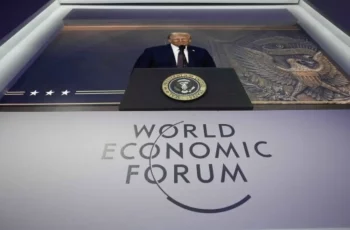Trump has some options if he takes them
US President Donald Trump, in the midst of his triumph ending the Gaza war and gaining the return of the Israeli hostages, is jacking up the pressure on Russia. The major threat, but not the only one, is the threat to deliver Tomahawk missiles to Ukraine that will be used to target assets inside Russia.

Russia has not won the war on the ground in Ukraine. Even without the Tomahawk, Russia will experience heavy losses to Ukrainian drones aimed at Russia’s energy infrastructure and military industries. Ukrainian raids on Russia happen nearly every night, just as Russian raids on Ukraine appear fairly persistent.
Russia has limited financial ability to replace its losses, and shut downs of power and equipment losses do not play well with the public.

Nonetheless there are limits to everything. How long can Ukraine sustain mounting losses, and how much reverse punishment can Russia take in pursuit of its goals in Ukraine? There are no answers to these questions, or even answers to how long the war itself will continue.
The modern battlefield has changed significantly. The use of drones and precision weapons, along with aerial-dropped mines, have made armored assaults nearly a thing of the past. Some say that the life of a main battle tank is a mere 72 hours, meaning that hardware will be rapidly destroyed and experienced crews are few and far between.

Observers say that Russia is now outproducing Ukraine in drone manufacturing and deployment, but not enough yet to change the battlefield significantly in Russia’s favor. Meanwhile new types of smart drones with artificial intelligence features are starting to appear, making drone lethality independent of their operators. Surprisingly, these drones, important ones fielded by Russia, are stuffed with US electronics including from the AI-leader, Nvidia. Whatever sanctions and export controls the US imposes, the system is like swiss cheese, full of holes and roundabouts, making the supply chain, as far as Russia is concerned, fairly secure.
Russia’s two main problems in the war come in two distinct directions.
A key problem is the conservative and risk-averse Russian military leadership. They are under great pressure to produce results and minimize casualties, largely contradictory objectives. With some 700,000 troops in the battle zone, Russia has not been able to mount a singular campaign against a Ukrainian strategic target. The proof is easy to illustrate: Pokrovsk, a key city and objective for Russia, remains mostly in Ukraine’s hands. The Russians were able to insert small squads into the south of the city, but the attempt to cut off supply lines, mainly in the north, were countered fairly effectively by Ukraine. Pokrovsk has been nothing much more than a squeeze play where Russia has not been able to squeeze hard enough.
Sooner or later Russia’s military will need to decide whether it can force a major advance. If they can’t, they cannot win the war.

The second problem is Russia’s lack of credible allies. North Korea is not a credible ally, and however many North Korean troops died in Kursk, on Russian territory, suggests that North Korea will not use its forces on Ukrainian territory. In any case, the heavy losses were a big blow to Kim Jong-Un’s credibility, and his tearful performance at funerals in Pyongyang was not much more than a cover up for failure.
Similarly Russia’s near neighbor, Belarus, wants to avoid engaging in the conflict, and has made it clear to Poland and others that Belarus is not a threat (even though Poland put a lot of troops and hardware on Belarus’s border).
Iran, a Russian ally, is all but worthless. Iran has been effectively neutered by the US and Israel, its nuclear program trashed, and much of its air defenses ruined. The Russians were smart to move production of Iranian drones to its own territory.
Likewise China, despite backdoor help to Russia in the form of supply chain support, deliberately has not been a player when it comes to Ukraine. China is always balancing its trade situation and geostrategic priorities, but Russia and Ukraine hardly matter, other than symbolic exercises and military parades.
This leaves Moscow isolated, and if Moscow cannot soon achieve a military victory, it will need to end the war in Ukraine. The part that is less certain is how long Ukraine can hang in against a powerful and persistent adversary.
President Trump instinctively knows this, and is playing the leverage game on Russia. The risk, for Trump, is to go too far and lead Putin and Russia to desperate measures. Unlike Trump, Putin’s future is tied up in the Ukraine outcome. Thus the risk of a bigger war, or the introduction of new classes of weapons, is lurking on the near-horizon.
It would seem Trump has to cook up a deal that Russia might find attractive. There are formulas that can end the war, and which give Russia half a loaf. The answers can be found in mitigating the Russian territorial annexations, except perhaps Crimea, and backing NATO away from Russia’s territory, a key Russian objective. Large buffer zones and reductions in military supplies is one promising area that needs to be explored.
A word about territorial mitigation. Russia has outright annexed a number of territories, Donbas (Luhansk and Donetsk), Zaporizhia, Kherson and Crimea. But with the exception of Luhansk and Crimea, Russia only holds around 75% of these territories. There is room for deals, for example mixed territorial administration, recognition of Russian rights, withdrawal of forces, mutually agreeable economic cooperation, and more that could result in a framework for a deal for two countries (Russia and Ukraine) in peace, not war. No one has proposed, let along discussed, solutions that can lead to a long term reconciliation between the major actors.
Trump also understands that Russia faces an economic crisis. Aside from petroleum exports, specialty metals including enriched uranium and titanium, and grain, Russia lacks a commercially viable domestic industrial base that can compete internationally. It is particularly deficient in electronics. The impending crisis is easy to visualize: the massive amounts of the Russian budget going into armaments production will no longer serve much purpose if the war ends. This means Russia could quickly transition from full employment, which is the case now, to pockets of serious unemployment. With troops returning home, and less conscription, jobs will be at a premium and the industrial base is not ready to absorb them. On the other hand, keeping the war going also is not sustainable -the costs are too high and government income too low to keep them running.
Bringing US investment to Russia could be very significant, but Russia needs to clean up its legal system that often plays havoc with foreign investors. This is no trifling matter where Russian government officials and industry leaders behave like predators instead of partners.
But Russia will need a bailout to make a deal. This is a Trump specialty. It needs to be matched with better ideas on an overall deal ending the war, as suggested above. The case of only a ceasefire does not square the circle.
Zelensky has said he will resign when the war ends. Trump needs to hold him to that decision, perhaps asking him to go sooner rather than later.
Trump has some options to do what he did for Israel and Gaza for Ukraine.
Source: author’s blog










Comments